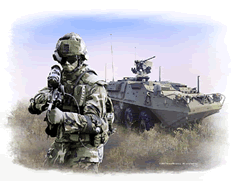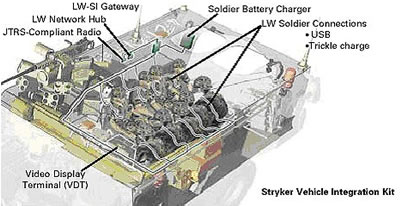Following evaluation of the Land warrior system over several years, the US Army decided to drastically simplify the system, making it less complex, more durable and suitable for realistic combat conditions. The resulting system is the Land warrior Stryker, or “Mounted Warrior”, now scheduled for completion and deployment by 2006. New features provide dismounted soldiers combat identification for enroute situational awareness and power recharge to reduce “friendly fire” incidents; CDA leader planning tool, weight and power reduction, scalable and tailored for operational missions, enables transition to Army Future Combat Systems interoperability, and path for technology insertions from Objective Force Warrior (OFW – currently designated Future Force Warrior or FFW) and other sources.
Mounted Warrior equips Army crew members assigned to Stryker vehicles and requires the use of a helmet mounted display for hands-free viewing and increased situational awareness. Following a competitive evaluation of various helmet mounted displays, held in August 2005, the Army selected the ProView S035 monocular helmet mounted display provided by Rockwell Collins. The same design has been qualified for use in the Army’s Land Warrior program.
Key capability of the system is its interoperability with the Stryker family of combat vehicles, attained through a Stryker Vehicle Integration Kit (VIK). When mounted on the vehicle, VIK provides voice intercome and radio communications, data communications and electrical power recharging connectivity through an umbilical connection. Voice and data connections are provided through an extension of the individual soldier’s personal Area Network system, providing intranetworking between team members as well as radio and data connectivity with external sources, carried through the vehicle’s intercom system. On dismounted operations, soldiers will have full communications via the vehicle’s radios and data systems, as long as they remain within wireless network’s effective range. When mounted, each soldier will also have seamless synchronization of tactical information, via data connection with the Army Battle Command System (ABCS) through the vehicle’s FBCB2 system. Prior to dismounting, the system will provide an update position of all associated elements, as received from the vehicle’s GPS system. The VIK will have battery recharging racks to replenish batteries drained during dismounted operations.
Additional parts of this article:
- Land Warrior & Stryker Warrior Programs
- Land Warrior System
- Land Warrior Infantry Combat Suite Stryker Vehicle Integration
- Future Force Warrior Infantry Combat Suite
- Future Force Warrior Uniform, Protection and Combat Gear
- Future Force Warrior Communication and Computation




















